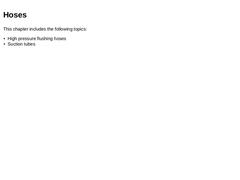
|
|
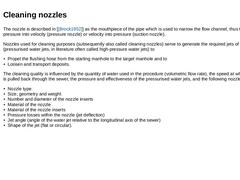
|
The nozzle is described in [ [Brock1952]] as the mouthpiece of the pipe which is used to narrow the flow channel, thus transforming pressure into velocity (pressure nozzle) or velocity into pressure (suction nozzle). Nozzles used for cleaning purposes (subsequently also called cleaning nozzles) serve to generate the required jets of liquid (pressurised water jets, in literature often called high-pressure water jets) to -
Propel the flushing hose from …
|
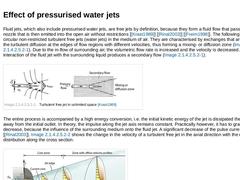
|
Fluid jets, which also include pressurised water jets, are free jets by definition, because they form a fluid flow that passes through a nozzle that is then emitted into the open air without restrictions [ [Kraat1989]] [ [Rinal2003]] [ [Freim1998]]. The following case involves circular non-restricted turbulent free jets (water jets) in the medium of air. They are characterised by exchanges that are triggered by the turbulent diffusion at the edges … |
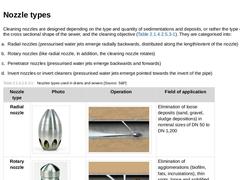
|
Cleaning nozzles are designed depending on the type and quantity of sedimentations and deposits, or rather the type of obstacle, the cross sectional shape of the sewer, and the cleaning objective (Table 3‑13). They are categorised into: -
Radial nozzles (pressurised water jets emerge radially backwards, distributed along the length/extent of the nozzle)
-
Rotary nozzles (like radial nozzle, in addition, the cleaning nozzle rotates)
-
Penetrator nozzles (…
|
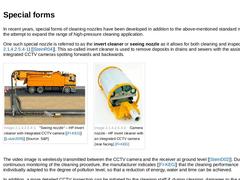
|
In recent years, special forms of cleaning nozzles have been developed in addition to the above-mentioned standard nozzle types in the attempt to expand the range of high-pressure cleaning application. One such special nozzle is referred to as the invert cleaner or seeing nozzle as it allows for both cleaning and inspection (Image 3‑36) [ [SteinR04]]. This so-called invert cleaner is used to remove deposits in drains and sewers with the assistance … |
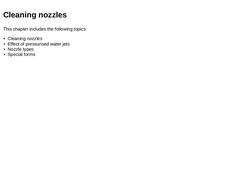
|
|
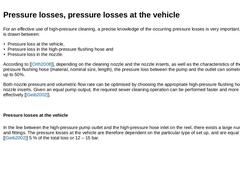
|
For an effective use of high-pressure cleaning, a precise knowledge of the occurring pressure losses is very important. A distinction is drawn between: -
Pressure loss at the vehicle,
-
Pressure loss in the high-pressure flushing hose and
-
Pressure loss in the nozzle.
According to [ [Orth2008]], depending on the cleaning nozzle and the nozzle inserts, as well as the characteristics of the high-pressure flushing hose (material, nominal size, length), … |

|
The highest pressure losses can be found in the high pressure flushing hose. According to [ [Geib2002]], the calculation of these losses, resulting from the turbulent flow, is performed using Equation 3‑7. (Formula: Pressure loss in the high-pressure flushing hose) According to this equation, the pressure loss in the high-pressure flushing hose is inversely proportional to the internal diameter and the hose length, the squared mean flow velocity and … |
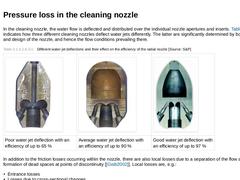
|
In the cleaning nozzle, the water flow is deflected and distributed over the individual nozzle apertures and inserts. Image 3‑41 indicates how three different cleaning nozzles deflect water jets differently. The latter are significantly determined by both the form and design of the nozzle, and hence the flow conditions prevailing there. (Table: Different water jet deflections and their effect on the efficiency of the radial nozzle) In addition to the … |
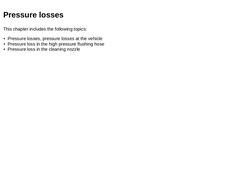
|
|
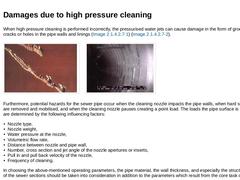
|
When high pressure cleaning is performed incorrectly, the pressurised water jets can cause damage in the form of grooves, flakes, cracks or holes in the pipe walls and linings (Image 3‑42) (Image 3‑43). (Image: Verified clay pipe damage as a result of the incorrect use of HP cleaning) (Image: HP cleaning damage) Furthermore, potential hazards for the sewer pipe occur when the cleaning nozzle impacts the pipe walls, when hard solid deposits are removed … |
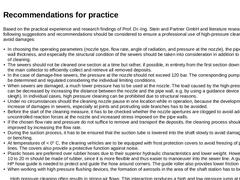
|
Based on the practical experience and research findings of Prof. Dr.-Ing. Stein and Partner GmbH and literature research, the following suggestions and recommendations should be considered to ensure a professional use of high-pressure cleaning in order to avoid damages: -
In choosing the operating parameters (nozzle type, flow rate, angle of radiation, and pressure at the nozzle), the pipe material, the wall thickness, and especially the structural …
|
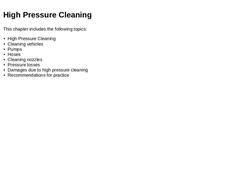
|
|
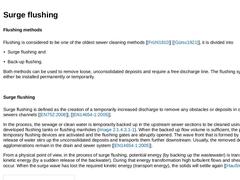
|
Flushing methods Flushing is considered to be one of the oldest sewer cleaning methods [ [Frühl1910]] [ [Gürsc1921]], it is divided into -
Surge flushing and
-
Back-up flushing.
Both methods can be used to remove loose, unconsolidated deposits and require a free discharge line. The flushing systems can either be installed permanently or temporarily. Surge flushing Surge flushing is defined as the creation of a temporarily increased discharge to remove … |
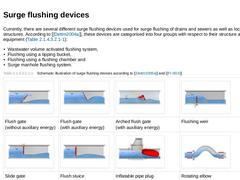
|
Currently, there are several different surge flushing devices used for surge flushing of drains and sewers as well as local drainage structures. According to [ [Dettm2004a]], these devices are categorised into four groups with respect to their structure and technical equipment (Image 3‑47): -
Wastwater volume activated flushing system,
-
Flushing using a tipping bucket,
-
Flushing using a flushing chamber and
-
Surge manhole flushing system.
(Table: Schematic … |
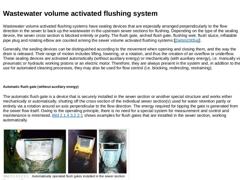
|
Wastewater volume activated flushing systems have sealing devices that are especially arranged perpendicularly to the flow direction in the sewer to back up the wastewater in the upstream sewer sections for flushing. Depending on the type of the sealing device, the sewer cross section is blocked entirely or partly. The flush gate, arched flush gate, flushing weir, flush sluice, inflatable pipe plug and rotating elbow are counted among the sewer volume … |
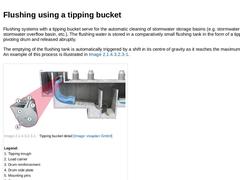
|
Flushing systems with a tipping bucket serve for the automatic cleaning of stormwater storage basins (e.g. stormwater sewer, stormwater overflow basin, etc.). The flushing water is stored in a comparatively small flushing tank in the form of a tipping bucket or pivoting drum and released abruptly. The emptying of the flushing tank is automatically triggered by a shift in its centre of gravity as it reaches the maximum filling level. An example of … |
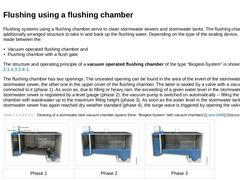
|
Flushing systems using a flushing chamber serve to clean stormwater sewers and stormwater tanks. The flushing chamber is an additionally arranged structure to take in and back up the flushing water. Depending on the type of the sealing device, a distinction is made between the: -
Vacuum operated flushing chamber and
-
Flushing chamber with a flush gate
The structure and operating principle of a vacuum operated flushing chamber of the type “Biogest-System“ … |
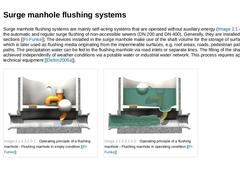
|
Surge manhole flushing systems are mainly self-acting systems that are operated without auxiliary energy (Image 3-72) for the automatic and regular surge flushing of non-accessible sewers (DN 200 and DN 400). Generally, they are installed in the starting sections [ [FI-Funke]]. The devices installed in the surge manhole make use of the shaft volume for the storage of surface water, which is later used as flushing media originating from the impermeable … |
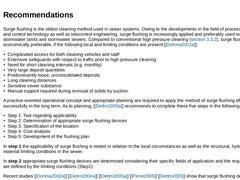
|
Surge flushing is the oldest cleaning method used in sewer systems. Owing to the developments in the field of process measuring and control technology as well as telecontrol engineering, surge flushing is increasingly applied and preferably used to clean stormwater tanks and stormwater sewers. Compared to conventional high pressure cleaning ( (High Pressure Cleaning)), surge flushing is economically preferable, if the following local and limiting … |
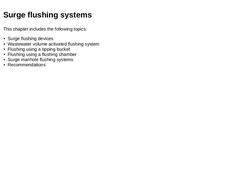
|
|

|
Back-up flushing In the case of back-up flushing, devices are introduced into the sewer that reduce its cross section, back up the sewage and thus, increase the flow velocity. Because of this back up, i.e. the difference in the water level in front of and behind the devices, these are driven forward and the flushing water flows around them. In the process, the unconsolidated deposits are removed and transported [ [Führb1980]]. The method of back-up … |
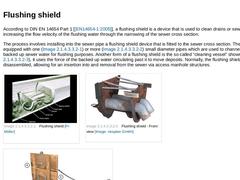
|
According to DIN EN 14654 Part 1 [ [EN14654-1:2005]], a flushing shield is a device that is used to clean drains or sewers by increasing the flow velocity of the flushing water through the narrowing of the sewer cross section. The process involves installing into the sewer pipe a flushing shield device that is fitted to the sewer cross section. The shield is equipped with one (Image 3‑77) or more (Image 3‑78) small diameter pipes which are used to … |

|
|
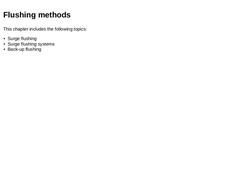
|
|